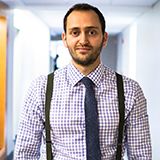The Doctors’ Book Club
Anthony Doerr’s All the Light We Cannot See
Rich men, trust not in wealth,
Gold cannot buy you health;
Physic himself must fade.
All things to end are made
–Thomas Nashe “A Litany in Time of Plague”
Anthony Doerr’s All the Light We Cannot See recounts the story of two children thrown into the crosswinds of the Second World War. Werner, a German orphan growing up in a mining town is recruited into the Nazi army for his exceptional ability of reconfiguring radios; meanwhile, Marie-Laure, a young Parisian girl who is rapidly losing her sight, is evacuated to Saint-Malo, a small coastal city in Brittany.
If their stories seem familiar, the characters themselves are anything but that. Doerr refuses to simplify Werner to the archetype of a typical Nazi soldier, crafting instead a character that is equal parts introspection and naïveté, sufferer and aggressor. So too, Doerr deliberately avoids reducing Marie-Laure’s blindness to the cliché of disability. Her condition does not grant her paradoxical powers, but rather allows her to meaningfully interact with the world in a profoundly novel way.
She learns to admire her universe through touch because “to really touch something, she is learning—the bark of a sycamore tree in the gardens; a pinned stag beetle in the Department of Etymology; the exquisitely polished interior of a scallop shell in Dr. Geffard’s workshop—is to love it.” The light she cannot see becomes her impetus for crafting new relationships with the physical world.
Though separated by politics and national borders, Werner and Marie-Laure, through a series of serendipitous events, become united against a common adversary, Sergeant Major von Rumpel. At first glance, von Rumpel represents a prototypical Nazi commander: Ruthless, methodical, and devoid of emotions. His mission—to compile the largest collection of jewels and art as a testament to Germany’s power—initially obscures his true goal of unearthing one single stone, the mysterious Sea of Flames. The diamond, a character in its own right, weaves in and out of the reader’s view, wreathed in subterfuge and shrouded in the myth of immortality.
As von Rumpel learns, multiple legends confirm that “the keeper of the stone would live forever.” This promise of immortality becomes his singular obsession as his body begins to give way to a rapidly progressing lymphoma. Feeling “the lymph nodes on either side of his neck compressing his esophagus and trachea,” his search for the diamond intensifies and morphs into a desperate attempt to save his own life as his steadfast empiricism and composure give way to quixotic hopes. The search for the Sea of Flames, therefore, becomes an analogue to regaining control of his fleeting life and to regaining a hold on his disappearing autonomy.
But Doerr is careful to remind the reader that von Rumpel’s disease functions as neither an excuse nor an explanation for his callous brutality. The numbers of war, too, are indisputably real and von Rumpel is not the only character handed an imminent death sentence. He compares the numbers: he has been given “four months. One hundred and twenty sunrises, one hundred and twenty more times he has to grad his corrupted body out of a bed and button it into a uniform.” Meanwhile, “the Eighth and Fifth German Armies retreat north through Italy… How many men? A hundred thousand.” How many sunrises does that add up to? And yet, even in the background of the unimaginable violence of war, there is something unmistakably familiar in von Rumpel’s selfishness and transformation from his reliance on facts to his faith in legends.
Disease invariably invokes a loss of control. For many, this aspect of illness can be one of the most difficult to bear. It is in these moments that myths and unorthodox explanatory models can play important roles in extracting meaning out of confusing and inexplicable situations.
The desire to persevere, to fight, to control one’s own life echoes throughout war, medicine, and life as a whole. And in these moments, traditional thinking often cannot offer a sufficient explanation for why terrible things occur and medicine can do nothing to help. For patients, who face a brutal and hopeless fight against their own bodies, hope and autonomy can therefore often be found outside the confines of traditional treatments. Where science fails, myth begins.
Next Month:
We will discuss Lily King’s Euphoria.
Questions to consider:
-What are the ethics and implications of studying a group of people?
-Does scientists have dehumanize their study subjects in order to remain objective?
-What makes a human sacrifice worth it “in the name of science?”
-Are the anthropologists in Euphoria doing their work for fame, the good of humanity, or other motives?
-How do we decide where to draw the line in research?
 Daniel Marchalik is completing his urologic surgery residency in Washington, D.C. He writes a monthly column for The Lancet and directs the Literature and Medicine Track at the Georgetown University School of Medicine.
Daniel Marchalik is completing his urologic surgery residency in Washington, D.C. He writes a monthly column for The Lancet and directs the Literature and Medicine Track at the Georgetown University School of Medicine.
Claire McDaniel is a second year medical student at Georgetown University School of Medicine in Washington, DC, participating in the school’s Literature and Medicine Track. Additionally, she is an MBA candidate at Georgetown University McDonough School of Business.
Competing interests: None declared.
